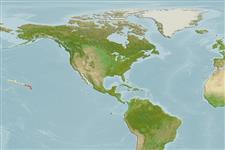Environment: milieu / climate zone / depth range / distribution range
Ecologia
marino; acqua dolce; salmastro benthopelagico; distribuzione batimetrica 1 - 22 m (Ref. 58302), usually 1 - 5 m (Ref. 58302). Subtropical
Eastern Central Pacific: endemic to Hawaii.
Length at first maturity / Size / Peso / Age
Maturity: Lm 18.8, range 18 - 20 cm
Max length : 22.2 cm SL maschio/sesso non determinato; (Ref. 41640)
Spine dorsali (totale): 10; Raggi dorsali molli (totale): 11-12; Spine anali 3; Raggi anali molli: 10 - 11. Preorbital serrae 11-18; body depth 2.3-2.7 in SL; dorsal profile of head of adults slightly concave; eye large, 2.6-2.95 in head length; second anal spine 86-98% length of third spine; pelvic spine 2.2-2.5 in head length; caudal concavity 1.8-2.0 in head length. Silvery, caudal fin dusky to dark gray with a narrow black posterior margin and often a pale band (Ref. 41640).
Found in brackish water, tide pools, over sand, and near rocks and reef in estuaries, back-reefs, or areas of strong surge (Ref. 58302). Inshore species, often seen in schools (Ref. 41640). Adults nocturnal (Ref. 41640).
Life cycle and mating behavior
Maturità | Riproduzione | Deposizione | Uova | Fecundity | Larve
Randall, J.E. and H.A. Randall, 2001. Review of the fishes of the genus Kuhlia (Perciformes: Kuhliidae) of the Central Pacific. Pac. Sci. 55(3):227-256. (Ref. 41640)
IUCN Red List Status (Ref. 130435)
Threat to humans
Harmless
Human uses
Informazioni ulteriori
BibliografiaAcquacolturaProfilo di acquacolturaVarietàGeneticaElectrophoresesEreditarietàMalattieElaborazioneNutrientsMass conversion
CollaboratoriImmaginiStamps, Coins Misc.SuoniCiguateraVelocitàModalità di nuotoArea branchialeOtolithsCervelliVista
Strumenti
Special reports
Download XML
Fonti Internet
Estimates based on models
Preferred temperature (Ref.
123201): 25 - 25.6, mean 25.3 °C (based on 30 cells).
Phylogenetic diversity index (Ref.
82804): PD
50 = 0.5002 [Uniqueness, from 0.5 = low to 2.0 = high].
Bayesian length-weight: a=0.01995 (0.01000 - 0.03980), b=3.08 (2.89 - 3.27), in cm total length, based on LWR estimates for this species & (Sub)family-body (Ref.
93245).
Trophic level (Ref.
69278): 3.0 ±0.25 se; based on food items.
Resilienza (Ref.
120179): Medio, tempo minimo di raddoppiamento della popolazione 1.4 - 4.4 anni (Preliminary K or Fecundity.).
Fishing Vulnerability (Ref.
59153): Low vulnerability (17 of 100).
